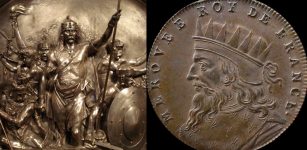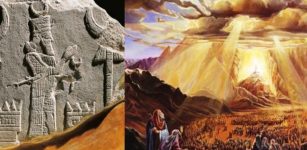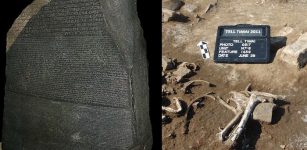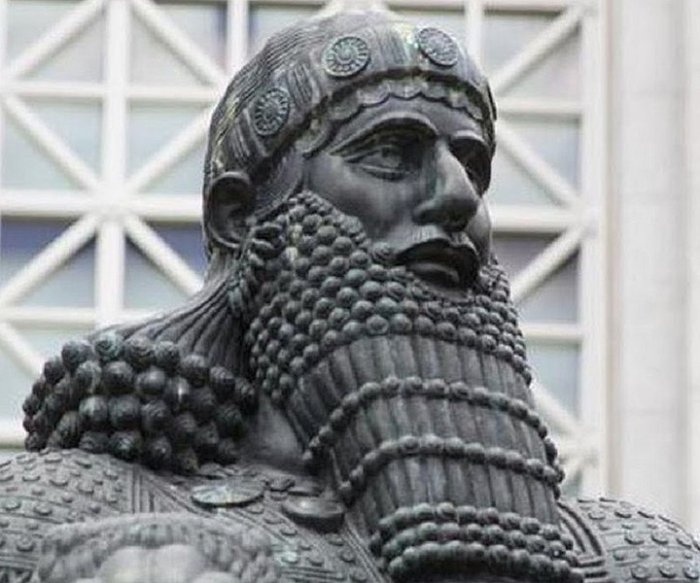Hammurabi: Great King Of Babylon And His Code Of Justice
A. Sutherland - AncientPages.com - Ancient Babylon was home to some powerful dynasties and rulers.
Hammurabi. Image credit: Windu1789 - CC BY-SA 4.0
One of them was Hammurabi, the sixth king in the Babylonian dynasty, who ruled in central Mesopotamia (modern Iraq) from 1792 to 1750 BC.
Who Was This Great King Of Babylon?
First, he proclaimed one of the earliest and most complete ancient legal codes but also contributed much more.
Hammurabi ("Hammu" means "family" in Amorite, and "rapi" means "great" in Akkadian) was one of the most significant historical figures of antiquity; he was a builder, conqueror, and lawmaker.
Ancient sources say that he built up Babylon until it was more powerful than Ur or any other city of its time and made the town the religious center.
Marduk, son of Enki, was declared Babylon's god and the greatest of all the gods, which gave him power and authority to relieve his father of his rank as chief god. Despite many protests, it happened according to Hammurabi's decision.
At the time Hammurabi ascended to the throne, Babylon was already a great state, which included, among others, Kish, Sippar, and Borsippa; however, Hammurabi recognized the authority of Shamshi-Adad I, king of Assyria and Mari, at that time. In the 30th year of his reign, he expanded his kingdom by conquering Larsa, Eshnunna, Assyria, and Mari. For the first time since the Third Dynasty of Ur, he created a powerful Babylonian Empire.
While involved in military and political advances, he also supervised his irrigation projects and the construction of fortifications and temples celebrating Babylon's patron deity, Marduk. Building spectacular pyramids, temples, and towers was difficult because there was no stone in Babylonia.
The Statue of Marduk depicted on a cylinder seal of the 9th century BC Babylonian king Marduk-zakir-shumi I. Detailed info, from Schaudig (2008). Image credit: Franz Heinrich Weißbach - Public Domain
According to Hammurabi's ingenious designs, the impressive structures of Babylon were built of bricks by molding and baking the clay, which hardened into bricks with perfect quality that has survived until today.
At its peak, Babylon, a trade and cultural center, was inhabited by about 200,000 people; at the center of this gigantic city with towers, palaces, and gardens, there was a vast ziggurat, estimated to be about 300 feet tall, according to archaeologists.
The splendid reign of Hammurabi lasted fifty−five years. After his death, great Babylon gradually declined.
The extent of the Babylonian Empire at the start and end of Hammurabi's reign, located in what today is modern-day Kuwait and Iraq. Image credit: MapMaster - CC BY-SA 4.0
Not much is left after Hammurabi's spectacular Babylon; no archives survived, and the only reliable historical documents that tell stories about Babylon are clay tablets unearthed at other locations.
Code Of Hammurabi
One of Hammurabi's most famous achievements is his law code (influenced mainly by Sumerian culture), which included many harsh punishments.
His Code, discovered in 1901, proclaimed at the end of Hammurabi's reign and supporting the doctrine of 'an eye for an eye' – is a collection of 282 laws and standards, indispensable rules for commercial interactions and punishments to meet the requirements of justice.
The black stone stele containing Hammurabi's Code was made from a single, four-ton slab of diorite, a durable but difficult to carve.
At its top is a two-and-a-half-foot relief carving of a standing Hammurabi receiving the law— symbolized by a measuring rod and tape—from the seated Shamash, the Babylonian god of justice.
Hammurabi’s Code. The prologue of the Code of Hammurabi (the 305 first inscribed squares on the stele). Some gaps in the list of benefits bestowed on cities recently annexed by Hammurabi may prove the tablet is older than the celebrated basalt stele (also in the Louvre). Image credit: Unknown artist - Louvre Museum
The rest of the seven-foot-five-inch monument is covered with columns of chiseled cuneiform script.
Hammurabi's Code was looted by later invaders and rediscovered in 1901 by a French archaeological team in present-day Iran.
The Code's 282 edicts – from family law to professional contracts and administrative law – are all written in 'if-then form. The edicts outline different standards of justice for the three classes of Babylonian society – the propertied class, freedmen, and enslaved people. A doctor's fee for curing a severe wound would be ten silver shekels for a gentleman, 5 shekels for a freedman, and two for an enslaved person.
Penalties for malpractice followed the same scheme: a doctor who killed a wealthy patient would have his hands cut off, while only financial restitution was required if the victim was enslaved.
Hammurabi's Code was not the earliest collection of laws, but his version became the most complete and famous in human history.![]()
Written by – A. Sutherland AncientPages.com Staff Writer
Updated on March 24, 2024
Copyright © AncientPages.com All rights reserved. This material may not be published, broadcast, rewritten or redistributed in whole or part without the express written permission of AncientPages.com
Expand for referencesReferences:
Goodspeed, G. S. A History of the Babylonians and Assyrians
Kriwaczek, P. Babylon: Mesopotamia and the Birth of Civilization
Charles River Editors. Babylon
More From Ancient Pages
-
 Visit The Palace Where Alexander The Great Was Born In Pella
Archaeology | Oct 21, 2020
Visit The Palace Where Alexander The Great Was Born In Pella
Archaeology | Oct 21, 2020 -
 Ruins Of Biblical City Of Corinth Discovered Underwater – Giant Monuments and Remains Of Lighthouse Still Well-Preserved
Archaeology | Dec 19, 2017
Ruins Of Biblical City Of Corinth Discovered Underwater – Giant Monuments and Remains Of Lighthouse Still Well-Preserved
Archaeology | Dec 19, 2017 -
 Draken Harald Hårfagre – World’s Largest Viking Ship On Its Way To U.S And Canada
News | Apr 27, 2016
Draken Harald Hårfagre – World’s Largest Viking Ship On Its Way To U.S And Canada
News | Apr 27, 2016 -
 Mystery Of The Headless Skeletons From Vráble
Archaeology | Apr 4, 2022
Mystery Of The Headless Skeletons From Vráble
Archaeology | Apr 4, 2022 -
 Beautiful Ancient Irish Legend Of The Blessing Of The Bees – Ancient Tradition Revived In Ireland Again
Ancient Traditions And Customs | Oct 11, 2017
Beautiful Ancient Irish Legend Of The Blessing Of The Bees – Ancient Tradition Revived In Ireland Again
Ancient Traditions And Customs | Oct 11, 2017 -
 On This Day In History: The Battle Of Fulford Was Fought – On Sep 20, 1066 AD
News | Sep 20, 2015
On This Day In History: The Battle Of Fulford Was Fought – On Sep 20, 1066 AD
News | Sep 20, 2015 -
 Rare Roman Mosaic Depicting The Adventures Of Greek Hero Achilles Discovered In Rutland, UK
Archaeology | Dec 4, 2021
Rare Roman Mosaic Depicting The Adventures Of Greek Hero Achilles Discovered In Rutland, UK
Archaeology | Dec 4, 2021 -
 Merovech – Legendary King Of The Franks And The Merovingian Dynasty
Featured Stories | Jan 18, 2019
Merovech – Legendary King Of The Franks And The Merovingian Dynasty
Featured Stories | Jan 18, 2019 -
 First Peoples Of Japan: Ainu Civilization And Its Unknown Origin
Civilizations | Oct 18, 2014
First Peoples Of Japan: Ainu Civilization And Its Unknown Origin
Civilizations | Oct 18, 2014 -
 Suprising Evolution Discovery – Human Temporal Lobes Are Not Very Large In Comparison With Other Primates
Archaeology | Mar 21, 2023
Suprising Evolution Discovery – Human Temporal Lobes Are Not Very Large In Comparison With Other Primates
Archaeology | Mar 21, 2023 -
 Food In Ancient Roman Funerary Meals Was Similar To That Consumed During Life
Archaeology | Aug 30, 2022
Food In Ancient Roman Funerary Meals Was Similar To That Consumed During Life
Archaeology | Aug 30, 2022 -
 Unique Study Of Skeletal Remains Reveals Grave Health Of Australian Pioneer Settlers
Archaeology | Apr 7, 2022
Unique Study Of Skeletal Remains Reveals Grave Health Of Australian Pioneer Settlers
Archaeology | Apr 7, 2022 -
 Collapse Of Ancient Mayan Capital Linked To Drought – New Study Suggests
Archaeology | Aug 20, 2022
Collapse Of Ancient Mayan Capital Linked To Drought – New Study Suggests
Archaeology | Aug 20, 2022 -
 Yama – Hindu God Who Rules Over The Dead And Souls And Guards Akashic Records
Featured Stories | Sep 17, 2018
Yama – Hindu God Who Rules Over The Dead And Souls And Guards Akashic Records
Featured Stories | Sep 17, 2018 -
 Is Biblical Mount Sinai Located In Har Karkom Where Mesopotamian Moon God Sin Was Worshipped?
Biblical Mysteries | Mar 20, 2017
Is Biblical Mount Sinai Located In Har Karkom Where Mesopotamian Moon God Sin Was Worshipped?
Biblical Mysteries | Mar 20, 2017 -
 Why Was Louis XIV Called The Sun King?
Ancient History Facts | Jul 11, 2019
Why Was Louis XIV Called The Sun King?
Ancient History Facts | Jul 11, 2019 -
 Mysterious Giant Rock Face Discovered On B.C’s Central Coast – Natural Or Man-Made Structure?
News | Mar 28, 2020
Mysterious Giant Rock Face Discovered On B.C’s Central Coast – Natural Or Man-Made Structure?
News | Mar 28, 2020 -
 Obsidian Flake From 45,000-Year-Old Tool Unearthed In Armenia
Archaeology | Jul 18, 2022
Obsidian Flake From 45,000-Year-Old Tool Unearthed In Armenia
Archaeology | Jul 18, 2022 -
 Äskekärrskeppet (‘Äskekärr Ship’) – Only Viking Ship Found With Runes
Featured Stories | Apr 18, 2024
Äskekärrskeppet (‘Äskekärr Ship’) – Only Viking Ship Found With Runes
Featured Stories | Apr 18, 2024 -
 Archaeologists Dug For Evidence Of The Rosetta Stone’s Ancient Egyptian Rebellion – Here’s What They Found
Archaeology | Mar 7, 2023
Archaeologists Dug For Evidence Of The Rosetta Stone’s Ancient Egyptian Rebellion – Here’s What They Found
Archaeology | Mar 7, 2023




